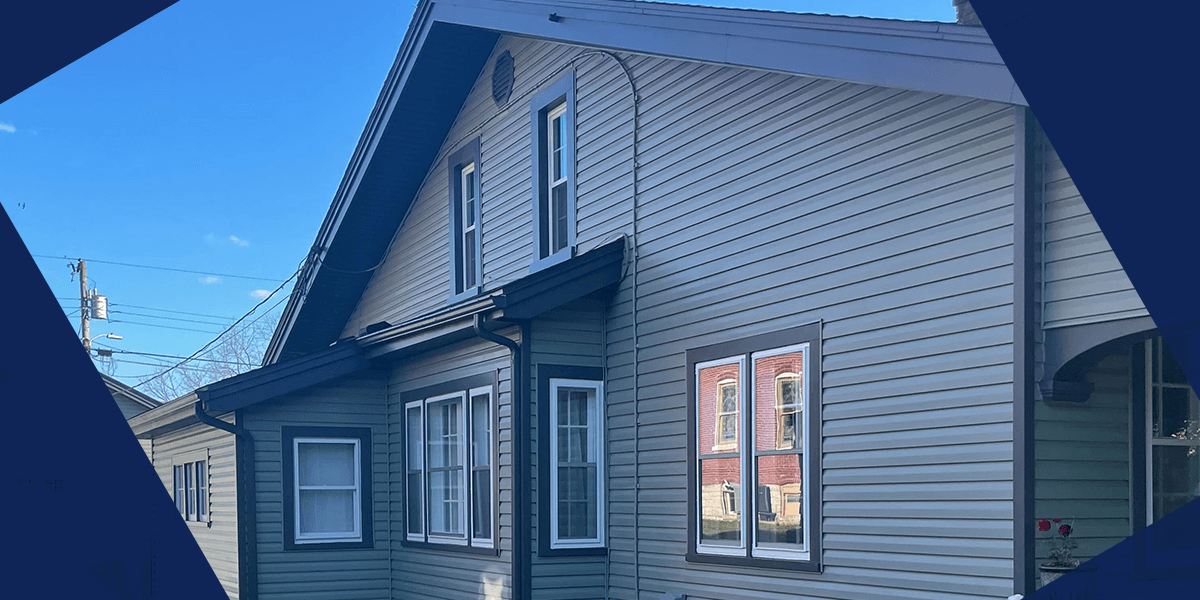Vinyl siding is typically a lower maintenance option as it is durable and comes in many different colors. However, over time, the original color of your vinyl siding can fade due to weather, sun exposure and age. The good news is you can breathe new life into your home by learning how to paint vinyl siding.
Benefits of Painting Vinyl Siding
Painting your vinyl siding instead of replacing it offers many benefits, with one of the top being you save money. The cost to paint vinyl siding is significantly less expensive than a complete replacement and takes less time. Some other benefits of painting your vinyl siding include:
- Aesthetics: If your siding currently has a weathered look, a fresh coat of paint can freshen up its appearance or make it look newer.
- A layer of protection: As your siding ages, it may lose its layer of protection. By painting the siding, you can reseal it and protect it from the elements.
- Increase the value of your home: Since painting your siding can give your home a fresh, new appearance, it could help increase your home’s value.
- Quickly create a new look: Painting allows you to quickly change the color as many times as you wish.
- Increase the life span of your siding: Adding another layer of protection to your siding is a great way to extend its life span.
Everything You Need to Paint Vinyl Siding
Before starting your paint job, you’ll want to ensure you have a ladder you can use on an even surface. You’ll need the following tools to paint vinyl siding:
- Hose with a spray nozzle
- Bucket
- Soft-bristled brush, sponge or rag
- Paint roller
- Paint brushes
You will also need the following materials when painting:
- Laundry detergent
- General-purpose cleaning powder
- Oxygen bleach
- Painter’s tape
- Masking material
How to Prep Vinyl Siding for Paint
One of the many great things about vinyl siding is you only need a primer for pitted or porous areas to make your paint job look seamless. Regardless of whether you need to use primer on your siding or you can start painting without it, it’s a good idea to clean your siding before starting.
Since your siding faces constant exposure to the elements, water alone may not be able to remove more stubborn dirt. To remove these stains:
- Mix a cleaning solution with 1/3 cup of powdered laundry detergent, 2/3 cup of general-purpose household cleaner and 2/3 cup oxygen bleach for every gallon of water you use.
- Stir the solution, then hand-scrub the siding.
- Work from the bottom up and rinse each section after scrubbing.
- Direct the water downward as you rinse to prevent it from getting behind the siding.

Step-By-Step Guide to Painting Vinyl Siding
As with any exterior painting job, you should wait to paint until you have a few days of good weather. Vinyl siding expands in hot temperatures and contracts in the cold, so avoiding cooler, humid or windy days is a good idea. Once you have ideal weather and you prep your siding, you’re ready to complete the following steps:
1. Choose Your Paint Color
Every type of vinyl has a specific amount of heat absorption. Since dark colors absorb more heat than lighter colors, consider a color that is lighter than the original siding color.
Many paint manufacturers also offer paint specifically for vinyl siding and many vinyl-safe colors that don’t absorb too much heat. These paints contain flexible and adhesive urethane and acrylic resins, making them an excellent choice for vinyl siding.
2. Clean and Repair Your Siding
As you clean your vinyl siding, you may notice cracks, warping or sections where the vinyl seems brittle. You can use caulk to smooth over divots and other minor bumps and scratches. If the siding has a lot of damage, the best thing to do will be to replace that specific panel entirely. Repairing or replacing the panels will ensure your siding looks smooth and uniform after painting.
3. Mask off Doors, Windows and Trims
Before you begin painting, use painter’s tape to mask any areas of your home you do not wish to paint. Some places where you can apply tape include the doors, windows and other hardware.
4. Set Up Paint Supplies and Use a Primer if Needed
Setting up drop cloths before you begin painting will protect any surrounding plants and surfaces from paint splatters. You can also use this time to find a flat, stable surface to set up your ladder and someone who can hold it in place as you paint panels farther up on your home. Once you have everything you need for painting vinyl siding, you’re ready to get started.
If your vinyl has pits or is porous, apply a primer to create a more uniform look. If your siding is in good shape and the original color has not worn away, you can apply the paint without a primer.
5. Apply Two Coats of Paint
Wait until any primer is dry before applying the vinyl siding paint. You will use a roller or paint sprayer to apply the paint and save your brushes for the corners and edges. Ensure the paint is even, and don’t apply too much in one section.
Let the first paint coat completely dry before moving on to the second. Follow the same application process with the second coat, and if you decide to do a third or a fourth, let the paint dry for 24 hours before applying each layer.
6. Clean Up
Once you’re satisfied with your paint job, it’s time to clean up. Pick up any drop cloths carefully so you don’t spread the paint around, close or dispose of the paint cans and clean your brushes and tools with hot and soapy water.
Use warm water to rinse roller brushes and paint brushes until the water runs clear, then use a roller spinner to remove any excess water. Hang your brushes to dry, then place them back in their protective sleeves. As you remove the painter’s tape, pull it at a 45-degree angle to avoid damaging the new paint.
Keep Your Home Looking Beautiful With Exterior Painting Services From The Ohio Painting Company®
If painting your vinyl siding is too large of a project to tackle alone or you’re short on time, the team at The Ohio Painting Company® is here to help. With decades of experience helping homeowners across Dayton, Cincinnati and the surrounding areas meet their exterior painting needs, we have the skills and knowledge to efficiently and effectively paint your vinyl siding. To learn more about our exterior painting services, request a quote today!







